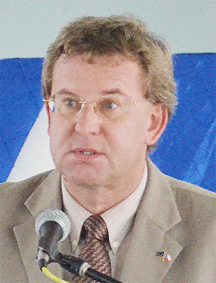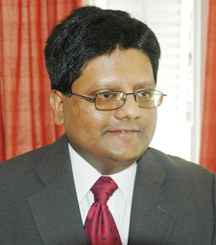The European Union (EU) and the government yesterday inked two financial agreements totalling $7.1 billion, the major portion of which will be plugged into the ailing sugar sector.
The agreements are aimed at financing a micro-hydropower system which will be built at Kato in Region 8 and the sugar industry.


The sum of $615 million will go towards the hydropower system – $460M from the EU and the remainder from the Guyana Government. The sugar sector will receive funding to the tune of $6.5 billion under the 10th European Development Funding (EDF) within the framework of the accompanying measures to cushion Europe’s price cuts to the sector.
At a press briefing following the signing of the agreements at the Ministry of Finance Boardroom on Main Street yesterday, Finance Minister Dr Ashni Singh said the occasion represents a significant milestone between the EU and Guyana adding that the two agreements are in two areas which are central to the national policy agenda of the government.
Since Europe modified its pricing arrangements with
Caricom, the sugar industry here has seen difficult times and Singh noted yesterday that the government was assisting the Guyana Sugar Corporation (GuySuCo) in reforming the sector.
“We have long recognised the need to implement reforms in the sugar sector to achieve a competitive and viable sugar industry and we have developed an action plan that involves a number of elements aimed at achieving exactly this …. a viable and competitive industry in the long term,” Singh stated.
He said the government has made significant investments in sugar in the last 20 years and he noted that over the past year in excess of US$200 million was spent on the sector, a majority of the financing which came from its EU partners. He singled out the Enmore sugar packaging plant as the most recent manifestation of government’s investment in the industry with EU support.
As regards the agreement signed yesterday, Singh said it is based on support delivery tied to certain objectives. He said the monies are delivered to the treasury before being disbursed to the industry.
Singh said the arrangement with the EU is designed with a number of indicators negotiated between both parties and includes examination of the “achievement of certain objectives in production, in cultivation, land conversion, more mechanized production of sugar… all aimed at improving efficiency.” He said the participation of private cane farmers is also an issue.
“So you have a set of key of objectives…broader objectives to increase production and effectivemess and then you have specific indicators that are indentified and targets that are identified within the sugar industry by the government and the EU,” Singh said.
“Once those are concluded and are included in the plan and in the agreement, the disbursement of the grant is tied to those indicators… so that’s the nexus between the indicators and the targets,” he said.
Singh said the industry has to make the necessary investments that are required, such as factory upgrades as well as upgrades in field and other equipment in order to meet the necessary requirements to receive the funding.
This latest grant provided by the EU is part of the agency’s Multi-Annual Sugar Programme 2011-2013 which supports the government in its efforts to improve the competitiveness and viability of the sugar industry and to promote agricultural diversification.
EU Ambassador Robert Kopecky said following the signing that the EU is satisfied with the performance of the sector, adding that yesterday’s signing was testimony to this. He added that there are significant accountability and responsibility factors within which the EU operates and these are backed by the institutions in Europe.
Kopecky said too that that the performance indicators mentioned by Singh would be improved adding that the country has the capacity to produce as much as 400,000 tonnes of sugar per year.
An EU press release said that the $6.5 billion will contribute to:
– Increasing sugar production and expanding market shares
– Diversifying the sugar industry and adding value to the final product
– Improving the efficiency and profitability of sugar cane and sugar production
– Reinforcing private cane farming
– Implementation of full solution Single Windows Automated Processing System (SWAPS) to facilitate agricultural exports.
The release noted that from 2006 when the accompanying measures programme started “the European Union has now made available Euro 72.5 Million to the Government of Guyana for the sugar sector (approximately $19.3 Billion at the current exchange rate).”
Kato
Meantime, the hydropower facility which will be built at Kato is being undertaken within the context of the Low Carbon Development Strategy (LCDS) as well as the provision of social services.
Singh said that the government recognizes that the delivery of electricity is important and it has been seeking solutions to provide the service outside the national grid. Among such measures is the solar panel programme, which is part of the wider renewable energy programme.
According to the EU, the hydropower system will comprise a 330-kilowatt micro-hydropower station with its primary energy source being the 36 m head waterfall in the Chiung River in the vicinity of Kato village.
It was noted that sufficient generating capacity for electrical services are to be provided to a secondary school complex which will be constructed by the Ministry of Education, existing government buildings such as the nursery/primary schools, the guest house, the police outpost, medical facilities, school dormitories and to also facilitate agro processing and commercial farming.
The system will provide electricity to the nearby village of Paramakatoi through a 16 km transmission line.








